Why a fight between Kenney and Alberta's doctors was inevitable, but the path to peace is less clear

Eager young doctors abandoning their dreams of setting up shop in their hometowns. Seasoned physicians, nearing retirement, deflated and dejected. In less than 12 months, the relationship between Alberta physicians and the United Conservative Party government has more than soured. It has imploded.
This should come as no surprise.
Premier Jason Kenney's UCP made its goal clear early — it planned to harness a ballooning health-care budget and take on the issue of physician pay. It laid out those plans in a report that was tailored specifically to make the case for its larger agenda and enshrined them in its first two budgets. It has spent months methodically enacting those plans.
But even more than that, the fight with Alberta's doctors is part of a larger push by the government to refashion Alberta and to do so quickly and aggressively. It's part of a pattern of conflict and condemnation that flows from the office of a premier with a long history of combativeness.
The MacKinnon report
Fuelled by an agenda to rein in spending and with a strong majority, the Kenney government set to work quickly after coming to power in April 2019. The UCP signalled early that health care — which at $20.6 billion eats up 42 per cent of the province's operating budget — would be a key target.
Hefty health-care budgets are common across Canada, but Alberta spends more per capita — $5,254 per person in 2018 — than any other province outside of Newfoundland and Labrador.

By September, a government-commissioned panel created in order to provide a framework and reasoning for the government's coming changes had laid out a plan to balance the budget.
The panel was headed by former Saskatchewan finance minister Janice MacKinnon, who had a public record of opinions and solutions that ensured the government got the recommendations — and justifications — it sought.
One of the key recommendations was to "limit the increasing cost of physician services," which totalled more than $5 billion in 2018-19 and made up 23 per cent of the health-care budget.
The report called for government to move doctors away from the traditional fee-for-service model — a move that has been made in other provinces. But it also introduced the idea of using legislation as a tool to make that happen, which would make Alberta the only province to force the change.
In the months following, the government introduced and passed Bill 21, allowing the health minister to terminate the province's physician compensation agreement with the Alberta Medical Association.
By February, Health Minister Tyler Shandro had invoked that new power, claiming talks with the AMA were at an impasse. The master agreement was terminated, and Shandro announced a plan to impose a number of sweeping changes to doctors' pay.
See how Alberta's health spending has compared to other provinces:
Some of the more controversial changes — including limits on how much family doctors get paid for longer appointments — were subsequently walked back.
But trust was shattered. The AMA is now suing the provincial government for $250 million.
The Klein years
Has the relationship ever been worse? It got close under Premier Ralph Klein.
"I would say that the docs and the government are in a state of open warfare," said John Church, a health policy expert in the department of political science at the University of Alberta.
"It's reminiscent of what went on during the early days of the Klein era during the 1990s."
Dr. Ernie Schuster has practised family medicine in Edmonton for 35 years and had a front-row seat during Klein's public sector spending cuts, which famously included blowing up the old Calgary General Hospital.

"All I can tell you is I've never seen such a low in the government-physician relationship as I'm seeing right now," he said.
For Church, the source of the conflict was the decision by the government to unilaterally tear up the master agreement with the AMA, a move that was made without notifying the association.
Both he and Schuster say that, even during the Klein years, when hundreds of million of dollars were pulled out of the system, the government found a way to bring doctors back into the decision-making process.
"The respect was there, while right now we feel there is very little respect for the profession," Schuster said.
The front lines
If the provincial government and physicians are at war, Dr. Christine Molnar is on the front lines as president of the Alberta Medical Association.
"The relationship between government and physicians is at an all-time low right now," Molnar said.
"It does look like it's a premeditated plan. That's the basis of our lawsuit."
The AMA's statement of claim, filed in April, accuses the government of bargaining in bad faith and denying the AMA access to arbitration, all of which the province denies.
When the Alberta government filed its statement of defence on July 9, the health minister reiterated a familiar line in a news release, saying the government's goal was to "hold the line on cost overruns while maintaining spending at the highest level ever."

The AMA released a survey on July 10 suggesting 42 per cent of respondents are considering leaving the province, which prompted a threat from Shandro to include doctors' earnings on a sunshine list of sorts.
The association, which isn't against inclusion on the list as long as it recognizes those payouts do not represent take-home pay after expenses, followed by publishing newspaper ads outlining its latest offer to the government, which was rejected.
The proposal, according to the association, caps physician compensation at the amount the government wants ($4.571 billion per year) for three years, with doctors taking fee cuts if spending exceeds that cap.
The latest salvo came on Wednesday, when it was revealed the health minister had ordered the College of Physicians and Surgeons of Alberta to change its standards of practice in order to prevent doctors from leaving their practices en masse — a backtrack of sorts to previous claims by the minister that doctors were not leaving their practices in any significant number.
Shandro's office did not respond to two requests for an interview for this story.
It's a dizzying back and forth that seems to escalate on a daily basis, but below it all the two sides broadly agree that things need to change.
It's the economy
Few would deny Alberta — with its boom-bust cycle stuck firmly in a bust — needs to reduce spending. In particular, health-care spending.
It's not even a new discussion.
The way doctors are paid has been fodder for a number of reports over at least the past two decades. But there has been little movement away from the traditional fee-for-service model in this province.
A recent paper from the University of Calgary's School of Public Policy called for the province to incentivize more doctors to move voluntarily to alternative payment plans more akin to a salary than set fees for patient visits.
It points to other provinces that have moved away from the fee-for-service model, including Ontario, which brought in higher-paying alternative plans for doctors as enticement that the authors say saves the system money down the road.

Alberta, the paper says, has the highest proportion of physicians paid by fee for service and some of the highest fee payments in Canada.
According to Jennifer Zwicker, the school's director of health policy, the trouble is Alberta has taken a heavy-handed approach to change — a tactic Zwicker argues likely stems from the long history of little progress.
At the same time, she said, the AMA needs to show a willingness to have constructive discussions about alternative payment strategies.
"In the current fiscal situation in Alberta, we do have to start to think about things differently. I'm not sure that's the mentality that's been coming forward," Zwicker said.
There are signs the AMA is open to moving in that direction. The association says it committed to looking at new payment models in its most recent offer to government.
The chaos percolating in Alberta's health-care system was further cemented with the Kenney government's recent introduction of Bill 30.
If passed, the omnibus bill would make it easier for private surgery facilities to set up shop and allow the Health Ministry to contract directly with private companies to run medical clinics.
The legislation also aims to push doctors away from the traditional fee-for-service model to a salary model by making it easier to negotiate individual contracts — known as ARPs — directly with the government rather than through the AMA.
That's a move many doctors reject, so why force the issue?
Kenney's philosophy
Lori Williams, a political scientist at Mount Royal University in Calgary, said "the million-dollar question" is why the government is taking such a combative stance with doctors.
She points to poor poll numbers for the government despite the province's success tackling the COVID-19 pandemic and speculates the fight with doctors is a big reason for the lack of a popularity bump.
While other premiers saw approval ratings soar during the pandemic by as much as 22 per cent, Albertans' feelings toward Kenney barely budged.
For example, one survey in late May found 56 per cent of Albertans felt the province would be better off without Kenney in charge — a disapproval rating far higher than those of other premiers and one that had only moved incrementally from 57 per cent in December.
"The last thing you want to be doing is going after front-line medical workers who are, at least in some cases, risking their lives for the health of Albertans," Williams said.

But this is a government led by a man who is known to seek out enemies and use them as rhetorical punching bags in service of his agenda. Teachers, nurses, government workers and environmentalists are among those who have felt under attack by the government.
And it's also common for Kenney and his government to meet resistance to that agenda with an all-out counter-assault. In just one example, when the Calgary Board of Education pushed back against cuts to its budget, the government brought in auditors and then threatened to fire the elected board.
The fight with doctors, then, is firmly grounded in a larger way of thinking within the government. And doctors — or the public service writ large — are an obvious mark.
Williams argues Kenney needs to move quickly in order to focus on the positive aspects of his party and its politics in the lead-up to the next election in March 2023.
"He's got to get the unpopular stuff, the tough stuff, the controversial stuff, out of the way, sooner than later," she said.
That could be a challenge as both sides dig in for a fight and the issue moves away from cost-cutting and into the realm of trust and working relationships.
Doctors packing up
As the war drags on, some battle-weary doctors are already giving up.
The province — which until recently struggled with a chronic shortage of family physicians — is now at risk of unravelling years of work to recruit and retain those doctors.
Dr. Lindsey Campbell had visions of working as a small-town family doctor while growing up in Alberta, but, just eight years out of medical school, she recently decided to pursue her career in Yukon instead.
She said she can understand the need to take a pay cut during tough times, but "being labelled as greedy and distrustful and being sometimes outright called liars by the government is just not a working environment [we] want to be in."

The sense of betrayal runs deep.
Dr. Annelies Noordman packed up and moved her family back to the Netherlands last week, after working in Alberta for 12 years.
"I'm not willing to sacrifice my own values to stay in Alberta," she said. "I am very pessimistic about my own profession and how I can provide the care in a way ... that I can live with."
Underpinning all this frustration is a whole lot of uncertainty.
Many rural family doctors run their own clinics and work in a hospital. That means they have expenses, including rent, insurance and staff salaries that don't stop when they're on hospital duty.
All that has proven increasingly difficult as the government levels one policy change after another, choosing to reverse some decisions and push ahead with others.
As a result, doctors are choosing to pull out of rural hospitals in a number of communities, including Lac La Biche, Stettler and Pincher Creek.
In Sundre, all eight family doctors at the Moose and Squirrel clinic stopped providing care at the local hospital on July 1, after giving 90 days' notice. They're now focused solely on working in their clinic.
The government has characterized the moves as job actions akin to strikes.
"We're left in a position where we're trying to read tea leaves from the legislature, " said Dr. Rob Warren, one of the Sundre doctors.
"I think, over the last three months, it's actually gotten personal. It's about hurting the other side now much more than about trying to find cost savings. And that happens when relationships break down.
"I think we're at the fighting-over-the-silverware point in this relationship."
An opening or two
But in a broken relationship — no matter what side you're on — rebuilding trust is always a sticking point.
The government, facing the prospect of losing the public relations battle, needs a way to press the reset button. And politically, it needs a way to do that without losing face.
The pandemic could offer that window, according to Zwicker of the University of Calgary's School of Public Policy.
"This is an opportunity to restart and reopen these discussions," she said, though both sides need to have an open mind.
But after months of battle, the province has signalled time and again it has no intention of retreating. And doctors are unlikely to back down without a change at the top, Warren said.
"I can guarantee you that if the government came forth and said that we are going to shuffle a new minister of health into that portfolio and we are going to commit to binding arbitration, that 95 per cent of doctors in this province would put down their torches and pitchforks, pick up their stethoscopes and go back to work."


